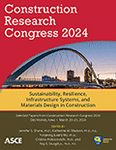Integrating Stakeholder Value Dynamics with Resilience Evaluation for Housing
Publication: Construction Research Congress 2024
ABSTRACT
Enhancing housing resilience requires us to choose a path that can systematically assess the value of resilience to the housing stakeholders. However, there is a lack of methods that assess housing resilience value by considering stakeholders’ perspectives. To address this gap, this paper proposes a human-centered resilience evaluation framework that integrates stakeholder value systems and dynamics with resilience evaluation. The model mathematically incorporates (1) the degree that a resilience asset fulfills stakeholder values (i.e., resilience fulfillment degree), (2) stakeholder value systems and dynamics in a disaster, and (3) the integration and alignment between resilience fulfillment degree and stakeholder value systems. The use of the model was illustrated through an experimental case study that assesses the resilience value of two alternative housing projects in the context of a hurricane disaster. This framework offers a unique approach that integrates human perspectives with resilience assessment and facilitates human-centered resilience designs or strategies.
Get full access to this article
View all available purchase options and get full access to this chapter.
REFERENCES
Adam, J. M., Parisi, F., Sagaseta, J., and Lu, X. (2018). “Research and practice on progressive collapse and robustness of building structures in the 21st century.” Engineering Structures, 173, 122–149.
Afshari, A., Mojahed, M., and Yusuff, R. M. (2010). “Simple additive weighting approach to personnel selection problem.” International journal of innovation, management and technology, 1(5), 511.
Ahmed, I., Gajendran, T., Brewer, G., Maund, K., von Meding, J., and MacKee, J. (2018). “Compliance to building codes for disaster resilience: Bangladesh and Nepal.” Procedia engineering, 212, 986–993.
Bardi, A., Buchanan, K. E., Goodwin, R., Slabu, L., and Robinson, M. (2014). “Value stability and change during self-chosen life transitions: self-selection versus socialization effects.” Journal of personality and social psychology, 106(1), 131.
Bosher, L. (2014). “Built-in resilience through disaster risk reduction: operational issues.” Building Research and Information, 42(2), 240–254.
Bruneau, M., Chang, S. E., Eguchi, R. T., Lee, G. C., O’Rourke, T. D., Reinhorn, A. M., and Von Winterfeldt, D. (2003). “A framework to quantitatively assess and enhance the seismic resilience of communities.” Earthquake spectra, 19(4), 733–752.
Buratti, C., Belloni, E., Merli, F., and Ricciardi, P. (2018). “A new index combining thermal, acoustic, and visual comfort of moderate environments in temperate climates.” Building and Environment, 139, 27–37.
Carr, L. J., Dunsiger, S. I., and Marcus, B. H. (2011). “Validation of Walk Score for estimating access to walkable amenities.” British journal of sports medicine, 45(14), 1144–1148.
Cimellaro, G. P., Renschler, C., Reinhorn, A. M., and Arendt, L. (2016). “PEOPLES: a framework for evaluating resilience.” Journal of Structural Engineering, 142(10), 04016063.
Cimellaro, G. P., Solari, D., and Bruneau, M. (2014). “Physical infrastructure interdependency and regional resilience index after the 2011 Tohoku Earthquake in Japan.” Earthquake Engineering and Structural Dynamics, 43(12), 1763–1784.
Chang, S. E., McDaniels, T., Fox, J., Dhariwal, R., and Longstaff, H. (2014). “Toward disaster‐resilient cities: Characterizing resilience of infrastructure systems with expert judgments.” Risk analysis, 34(3), 416–434.
Gosain, P., Zhang, L., and Ganapati, N. E. (2022). “Understanding multisector stakeholder value systems on housing resilience in the City of Miami.” International Journal of Disaster Risk Reduction, 77, 103061.
Kammouh, O., Cimellaro, G. P., and Mahin, S. A. (2018). “Downtime estimation and analysis of lifelines after an earthquake.” Engineering Structures, 173, 393–403.
Ke, M. T., Yeh, C. H., and Jian, J. T. (2013). “Analysis of building energy consumption parameters and energy savings measurement and verification by applying eQUEST software.” Energy and Buildings, 61, 100–107.
Liu, J. J., Reed, M., and Girard, T. A. (2017). “Advancing resilience: An integrative, multi-system model of resilience.” Personality and Individual Differences, 111, 111–118.
Morelli, A., Taramelli, A., Bozzeda, F., Valentini, E., Colangelo, M. A., and Cueto, Y. R. (2021). “The disaster resilience assessment of coastal areas: A method for improving the stakeholders’ participation.” Ocean and Coastal Management, 214, 105867.
NAS (National Academy of Science). (2012). Disaster Resilience: A National Imperative. <https://abag.ca.gov/sites/default/files/disaster_resilience_a_national_imperative.pdf>(Mar. 10, 2022).
Neighborhoodscout. (2022). Miami, FL crime analytics. <https://www.neighborhoodscout.com/fl/miami/crime>(Mar. 20, 2022).
Bekker, T., Buzina, M., and Tupikova, O. (2020). “Problems of Housing Affordability Improvement and Development of Residential Construction in Vladivostok.” IOP Conference Series: Materials Science and Engineering, 753(4), 042065.
Ouyang, M., Dueñas-Osorio, L., and Min, X. (2012). “A three-stage resilience analysis framework for urban infrastructure systems.” Structural safety, 36, 23–31.
Tokazhanov, G., Tleuken, A., Durdyev, S., Otesh, N., Guney, M., Turkyilmaz, A., and Karaca, F. (2021). “Stakeholder based weights of new sustainability indicators providing pandemic resilience for residential buildings.” Sustainable Cities and Society, 75, 103300.
Tormos, R., Vauclair, C. M., and Dobewall, H. (2017). “Does contextual change affect basic human values? A dynamic comparative multilevel analysis across 32 European countries.” Journal of Cross-Cultural Psychology, 48(4), 490–510.
Zhang, L., and El-Gohary, N. M. (2021). “Axiology-Based Valuation Modeling for Human-Centered Decision Making in Building Planning and Design.” Journal of Construction Engineering and Management, 147(11), 04021138.
Zhang, L., and El-Gohary, N. M. (2016). “Discovering stakeholder values for axiology-based value analysis of building projects.” Journal of Construction Engineering and Management, 142(4), 04015095.
Saaty, R. W. (1987). “The analytic hierarchy process—what it is and how it is used.” Mathematical modelling, 9(3-5), 161–176.
Zorn, C. R., and Shamseldin, A. Y. (2015). “Post-disaster infrastructure restoration: A comparison of events for future planning.” International Journal of Disaster Risk Reduction, 13, 158–166.
Information & Authors
Information
Published In
History
Published online: Mar 18, 2024
Authors
Metrics & Citations
Metrics
Citations
Download citation
If you have the appropriate software installed, you can download article citation data to the citation manager of your choice. Simply select your manager software from the list below and click Download.
